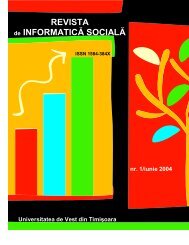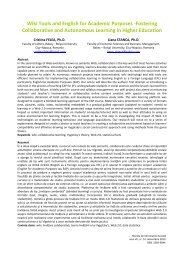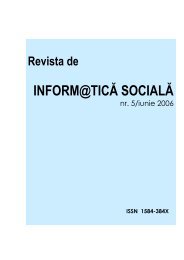Overall, we can therefore sum up one <strong>of</strong> the main evi<strong>de</strong>nce coming out from our research by sayingthat in the media diet <strong>of</strong> our university stu<strong>de</strong>nts, the Internet is by far the most preferred media,followed (at a certain distance) by the television, while the radio has a residual place. At a nationallevel, consi<strong>de</strong>ring the whole Italian population, the opposite seems to hold: the television is in factthe most preferred media, followed by the radio and by the Internet. Reading book is an activity thatconcerns only a minority <strong>of</strong> the overall population; even if the propensity to read book seems to beslightly above the national average in our sample, still it has to be consi<strong>de</strong>red that the majority <strong>of</strong>our sample <strong>of</strong> university stu<strong>de</strong>nts doesn’t read any book at all, or reads no more than five books in ayear.As already said, a significant part <strong>of</strong> our questionnaire was also focused on the diffusion and use <strong>of</strong>tools <strong>of</strong> the so-called social web, or web 2.0: blog, social network sites, and communities. Data onthe diffusion <strong>of</strong> blogs seem to provi<strong>de</strong> a kind <strong>of</strong> mixed evi<strong>de</strong>nce, and overall the phenomenon surely<strong>de</strong>serves additional investigations. First <strong>of</strong> all, there is a slight <strong>de</strong>crease in the percentage <strong>of</strong> subjectswho positively answer to the question “Do you have your own blog?”, that goes from 42.2% <strong>of</strong> thesample in 2008 to 35.7% in 2009. On the other si<strong>de</strong>, it is interesting to look specifically at theintensity <strong>of</strong> substantial involvement in blogging, that could be assessed by consi<strong>de</strong>ring thefrequency with which the blog itself is updated; the percentage <strong>of</strong> respon<strong>de</strong>nts who say they neverupdate their blog increases, from 28.2% in 2008 to 43.3% in 2009, while at the same time there is aslight increase in the percentage <strong>of</strong> regular bloggers, who update their blog every day (from 5.2% to8,2%). Obviously, we cannot extrapolate any long term trend as we got only two years <strong>of</strong>observations, but we can postulate that a number <strong>of</strong> subjects are shifting from the use <strong>of</strong> blogs to theuse <strong>of</strong> some kind <strong>of</strong> social networks (in particular, in the case <strong>of</strong> our sample, to Facebook, as wewill see); this might contribute to explain why the number <strong>of</strong> bloggers is diminishing, while at thesame time the number <strong>of</strong> regular bloggers is raising.The activity <strong>of</strong> reading other people’s blogs seem to be <strong>de</strong>clining as well: in 2008, stu<strong>de</strong>nts whoreported reading others’ blogs were in fact almost 8 out <strong>of</strong> 10, while in 2009 this number dropsdown to less than two out <strong>of</strong> three. The percentage <strong>of</strong> those who read other people’s blogs every dayremains substantially unchanged, while there is an increase in the number <strong>of</strong> those who read theblog “a few times a month” and a corresponding <strong>de</strong>crease in the number <strong>of</strong> those who read the blog“a few times a week”. The majority <strong>of</strong> our sample (55.1%) do not post comment on others’ blogs,and there is only a small percentage <strong>of</strong> subjects who <strong>de</strong>clare to post comments on a regular basis.One <strong>of</strong> the most significant trends that clearly comes out <strong>of</strong> our data concerns, in any case, what wecan label as a real “Facebook phenomenon”. It is worth remembering that the boom <strong>of</strong> popularity <strong>of</strong>Facebook in Italy substantially started in the summer <strong>of</strong> 2008. According to data provi<strong>de</strong>d byComScore, in the month <strong>of</strong> August 2008 there were over one million and three hundred thousandvisits to this site, with an annual increase <strong>of</strong> 961%, while the third quarter <strong>of</strong> 2008 saw Italy headingthe list <strong>of</strong> countries with the largest increase in the number <strong>of</strong> users (+135%).The evolution <strong>of</strong> the phenomenon can be followed thanks also to the Facebook Observatory(http://www.vincos.it/osservatorio-facebook/), according to which the Italian members <strong>of</strong> Facebookwere 216.000 in January 2008, 622.000 in August, 1 million and 294 thousand in September and upto 5.587.000 in December 2008. Also our data clearly confirm a radical increase in the number <strong>of</strong>subjects who have a Facebook account, that goes from 7.9% in 2008 to 59.4% in 2009; at the sametime, the percentage <strong>of</strong> those who even don’t know about Facebook at all drops down from 50.4%to 2.2% (Figure 4). It seems that Facebook is mostly used in or<strong>de</strong>r to meet new friends, as the37.2% <strong>of</strong> our sample reports this as the main motivation for opening an account on this site. The15.8% <strong>of</strong> our sample uses this site for general entertainment purposes, while the 9.5% uses it mainlyas an instant messaging tool.
70605050.4Do you know Facebook?59.4403020100<strong>No</strong>2.22623Yes, but Idon't use it8.210.27.9 7.55.3I seldom useitI <strong>of</strong>ten use itn.a.20082009Figure 4 – The diffusion <strong>of</strong> Facebook (N=1086 for 2008, N=1123 for 2009)It’s interesting to compare Facebook with other sites that are usually consi<strong>de</strong>red among the mostprominent features <strong>of</strong> the Web 2.0; this analysis shows that only a minority <strong>of</strong> our sample actuallymake use <strong>of</strong> this type <strong>of</strong> tools, in particular if we look to services that support activities such associal bookmarking, sharing and microblogging. YouTube remains by far one <strong>of</strong> the most popularsite: only the 2,1% <strong>of</strong> the sample does not know about it, while the 54.9% <strong>of</strong> the sample “<strong>of</strong>ten usesit” (with a substantial increase from the data <strong>of</strong> the 2008 survey, which was at 40.2%) and the28.1% “seldom uses it”. Wikipedia too is quite a popular site, with the 51.6% <strong>of</strong> our sample who<strong>de</strong>clares to <strong>of</strong>ten use this online encyclopaedia, and only 3.7% not knowing about it at all.Data concerning MySpace are interesting because this is the only site whose popularity actually is<strong>de</strong>creasing between 2008 and 2009: even if still well known (only a stu<strong>de</strong>nt out <strong>of</strong> ten does notknow about it), the percentage <strong>of</strong> subjects who do not use it goes up from 44.2% in 2008 to 52.8%in 2009, while the percentage <strong>of</strong> subjects who “<strong>of</strong>ten uses it” goes down from 15% to 9.6% (Figure5). It is likely that this <strong>de</strong>crease has to be somehow connected with the explosive growth <strong>of</strong>Facebook, as we can postulate a sort <strong>of</strong> competition between these two sites, in analogy to what hasalready happened in other countries (see for example the analysis ma<strong>de</strong> by Boyd, 2008, for whatconcerns the US).
- Page 1: Revista de Informatica Sociala 14 /
- Page 7: ● ● ●CONTENTS● ● ●[9-20
- Page 10 and 11: THE TRANSITION FROM OLD TO NEW MEDI
- Page 12 and 13: 30252023.420.325.11510500.85.5Never
- Page 16 and 17: n.a.I often use itI seldom use it6.
- Page 18 and 19: - Traditional web use: searching th
- Page 20 and 21: 19. Kvavik R.B., Caruso J.B. and Mo
- Page 22: IntroductionIn 1995, Bernie Dodge o
- Page 25 and 26: The Web-Inquiry Project [WIP] is a
- Page 27 and 28: and even orally. The teacher will a
- Page 29 and 30: environment in which the teacher gu
- Page 31 and 32: Transformation Through Online Learn
- Page 33 and 34: INTRODUCTIONLeading practitioners a
- Page 35 and 36: learning. We also describe how the
- Page 37 and 38: Some of these transformations are b
- Page 39 and 40: Recently, Twigg has received suppor
- Page 41 and 42: Stage III: Unbundled Learning, Mark
- Page 43 and 44: perhaps using Second Life-like virt
- Page 45 and 46: performance. Indeed, Stage V will l
- Page 47 and 48: Free-Range Open LearningOver time,
- Page 49 and 50: New communities, tools and services
- Page 51 and 52: Embed enterprise-wide predictive an
- Page 53 and 54: In collaboration with Strategic Ini
- Page 55 and 56: Wiki Tools and English for Academic
- Page 57 and 58: eality. Besides being an additional
- Page 59 and 60: StudentPage 1StudentPage nTeacher
- Page 61 and 62: 100%90%80%70%60%50%40%30%20%10%0%Ac
- Page 63 and 64: 200Correlation View/Page Edits150Vi
- Page 65 and 66:
14. http://eacea.ec.europa.eu/llp/s
- Page 67 and 68:
Simularea şi comunicarea electroni
- Page 69 and 70:
RespondenţiRăspunsuriLa nivelul
- Page 71 and 72:
RespondenţiRăspunsuriLa nivelul
- Page 73 and 74:
Respondenţii au fost rugaţi să i
- Page 75 and 76:
Itemul 9 doreşte să identifice ti
- Page 77 and 78:
Identificara opţiunii, chiar şi p
- Page 79 and 80:
EşantioaneRăspunsuri/Ranguriagita
- Page 81 and 82:
modalităţile practice prin care u
- Page 83 and 84:
1. INTRODUCEREÎn prezent, complexi
- Page 85 and 86:
Figura 1. Analiza grafică a evolu
- Page 87 and 88:
Faţă de această situaţie se deg
- Page 89 and 90:
variabilele acesti noi culturi cybe
- Page 91 and 92:
INTRODUCEREÎncă din anul 2000 am
- Page 93 and 94:
după tipul lecţiei: prezentare de
- Page 95 and 96:
Funcţiile oferite de AEL asigură
- Page 97 and 98:
• elevi/studenţi, beneficiari di
- Page 99 and 100:
Se poate folosi cadrul formal de co
- Page 102 and 103:
Evaluarea formativă este comentari
- Page 104 and 105:
Rezultatele elevilor, pe itemi:Diag
- Page 106 and 107:
Nr. Denumirea activităţii AEL MOO
- Page 108 and 109:
SEMNAL EDITORIALLaura MALITA, Vanna
- Page 110:
IN MEMORIAMConstantin TraianCHEVERE













